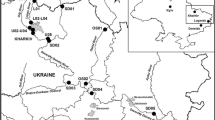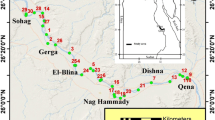Abstract
This paper describes a hydrochemical study held at Alambari river, which crosses the installations of Henrique Lage refinery (Revap), São José dos Campos city, São Paulo State, Brazil. The hydrochemical characterization of the Alambari river waters allowed to assess its quality and verify the presence of domestic and/or industrial effluents and other environmental impacts caused by urbanization and refinery activities. Physicochemical parameters, inorganic compounds, heavy metals, total dissolved solids, dissolved radon, and BTEX were analyzed in rainwater and 32 water samples collected at Alambari river which provided a robust dataset for this study. The water samples exhibited similar hydrochemical pattern, except in one case that yielded discrepant values for most of the analyzed parameters. This monitoring point indicated excessive contribution of domestic effluents as evidenced by its high content of surfactants and also of sewage effluents, as pointed out by its higher concentration of chloride and nitrate. Piper’s diagram highlighted that the hydrochemical facies of rainwater and surface water are bicarbonate sodic. Gibbs boomerang diagrams suggest the dominant influence of rainwater dilution effects on the hydrochemical composition of the Alambari river waters. It was not possible identify that the refinery affects the water quality in relation to the parameters analyzed, but the possibility of contamination by other compounds or contamination of soil and sediments is not ruled out.











Similar content being viewed by others
References
Atkinson, J. C. (2021). Baseline evaluation of legacy hydrochemical data for the Republican River watershed, southcentral Nebraska, USA. Environmental Earth Sciences, 80(3), 77.
Blume, K. K., Macedo, J. C., Meneguzzi, A., Silva, L. B., Quevedo, D. M., & Rodrigues, M. A. S. (2010). Water quality assessment of the Sinos River, Southern Brazil. Brazilian Journal of Biology, 70(4), 1185–1193.
Bonotto DM (1996) Hydrogeochemical behaviour of 222Rn and uranium isotopes 238U and 234U under laboratory controlled conditions and in natural systems. Post PhD thesis, UNESP-São Paulo State University, Rio Claro, 223 pp (in Portuguese)
Brazilian Ministry of Health (2021) Rule No. 2914 published in 12 December 2011. Procedures for controlling and surveillance of water quality for human consumption and its potability standard. Brasilia, DF, 33 pp (in Portuguese)
Carvalho, A. M. A. D., Vidal, A. C., & Chang, H. K. (2011). Delimitation of Taubaté basin basement. Geology USP, 11(1), 19–32. (in Portuguese).
Clayton, C. G. (1983). Nuclear Geophysics (p. 479). Pergamon.
Climate Data (2018) São José dos Campos climate data. https://pt.climate-data.org/america-do-sul/brasil/sao-paulo/sao-jose-dos-campos-6151. Accessed 03 Sept 2018 (in Portuguese)
CONAMA (2005) Resolution No. 357 published in 17 March 2005. CONAMA (National Council of Environment), pp 58–63 (in Portuguese)
DFPM (1966) The mining code, the mineral waters code and how applying research in a mineral deposit. DFPM (Division for Supporting the Mineral Production), ed. 8, Rio de Janeiro (in Portuguese)
Durridge Co. (2009a) RAD7 RAD H2O Radon in Water Accessory-Owner’s Manual. Durridge Co. Inc., Bedford, MA, USA
Durridge Co. (2009b) RAD7 Radon Detector-User Manual. Durridge Co. Inc., Bedford, MA, USA
Faure, G. (1991). Principles and Applications of Inorganic Geochemistry (p. 626). MacMillan Publishing Co.
Feng, J. L., Wang, G. L., Sun, J. H., Sun, S. P., & Liu, X. F. (2010). Metals in water and surface sediments from Henan reaches of the Yellow River, China. Science China Chemistry, 53(5), 1217–1224.
Flügge, S., & Zimens, K. E. (1939). The determination of grain size and diffusion constants from the emanating capacity (The theory of the emanation method). Journal of Physical Chemistry B, 42, 179–220. (in German).
Gaillardet, J., Viers, J., & Dupré, B. (2003). Natural Abundances of Trace Elements in River Waters. Treatise on Geochemistry, 5, 225–272.
Galvin, R. M. (1996). Occurence of metals in waters: An overview. Water SA, 22(1), 7–18.
Ghimire, N. P., Adhikari, N., Pant, R. R., & Thakuri, S. (2021). Characterization of water quality in West-Seti and Tamor River basins, Nepal. Scientific World, 14(14), 106–114.
Gibbs, R. J. (1970). Mechanisms controlling world water chemistry. Science, 170, 1088–1090.
Hach (2000) Water Analysis Handbook, 4 ed. Hach Company, Loveland, CO, USA
Hem, J. D. (1959). Study and interpretation of the chemical characteristics of natural waters. USGS Water Supply Paper, 1473, 1–269.
Kumar, P. J. S. (2014). Evolution of groundwater chemistry in and around Vaniyambadi industrial area: Differentiating the natural and anthropogenic sources of contamination. Chemistry of the Earth, 74, 641–651.
Mancini F (1995) Stratigraphy and aspects of deformation tectonics from Pindamonhangaba Formation, Taubaté basin, SP. MS Dissertation, USP-São Paulo University, São Paulo (in Portuguese)
Morel FMM, Hering JG (1993) Principles and applications of aquatic chemistry. Wiley & Sons Inc., New York.
Piper, A. (1944). A graphic procedure in the geochemical interpretation of water-analyses. Trans Amer Geophys Union, 25(6), 914–928.
Qishlaqi, A., Kordian, S., & Parsaie, A. (2016). Hydrochemical evaluation of river water quality: A case study. Applied Water Science, 7(5), 2337–2342.
Riccomini C, Sant’anna LG, Ferrari AL (2004) Geological evolution of continental rift from southeast Brazil. In: Mantesso-Neto V, Bartoreli A, Carneiro C, Neves BBB (eds), Geology of South American continent: evolution of the Fernando Flávio Marques de Almeida work. SBG (Brazilian Society of Geology), São Paulo, pp 673 (in Portuguese)
Riccomini C (1989) Continental rift from southeast Brazil. PhD Thesis, USP-São Paulo University, São Paulo (in Portuguese)
Schoeller H (1962) Groundwaters. Paris, Masson & Cie. (in French)
Singh, K. P., Mohan, D., Singh, V. K., & Malik, A. (2005). Studies on distribution and fractionation of metals in Gomti river sediments-a tributary of the Ganges, India. Journal of Hydrology, 312(1–4), 14–27.
Tiffany, M. A., Winchester, J. W., & Loucks, R. H. (1969). Natural and pollution sources of iodine, bromine, and chlorine in the great lakes. Journal of Water Pollution Control Federation, 41(7), 1319–1329.
Vidal, A. C., & Chang, H. K. (2004). Geostatistical analysis of salinity of aquifers from Taubaté basin. Braz J Geol, 34(1), 109–116. (in Portuguese).
Vidal, A. C., Fernandes, F. L., & Chang, H. K. (2004). Distribution of sandstones at Taubaté basin (SP). Geosciences, 23(1/2), 55–66. (in Portuguese).
WHO (World Health Organization) (1986) Drink water quality guidelines, vols. I-III. WHO, Geneva (in French)
WHO (World Health Organization) (2000) Environmental Health Criteria, 214. Human exposure assessment. International Programme on Chemical Safety. WHO, Geneva
Acknowledgements
IGL thanks CNPQ (National Council for Scientific and Technological Development) in Brazil for the MS scholarship, as well UNESPetro for the infrastructure access. One anonymous reviewer is greatly thanked by helpful comments that improved the readability of the manuscript.
Author information
Authors and Affiliations
Corresponding author
Ethics declarations
Conflict of Interest
The authors declare no competing interests.
Additional information
Publisher's Note
Springer Nature remains neutral with regard to jurisdictional claims in published maps and institutional affiliations.
Supplementary Information
Below is the link to the electronic supplementary material.
Rights and permissions
About this article
Cite this article
Lee, I.G., Bonotto, D.M. Contaminants Inputs at Alambari river, São José dos Campos city, São Paulo State, Brazil. Water Air Soil Pollut 232, 487 (2021). https://doi.org/10.1007/s11270-021-05437-0
Received:
Accepted:
Published:
DOI: https://doi.org/10.1007/s11270-021-05437-0




